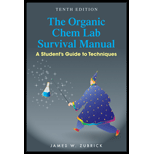
Interpretation:
You are drying a product with anhydrous magnesium sulfate and not entirely sure if you added enough. The phrase “If you see drying agent in the flask, its dry” in this context is to be discussed.
Concept Introduction:
➢ A drying agent is a chemical used to remove water from an organic compound that is in solution. Magnesium sulfate, Potassium carbonate, phosphorous pentoxide, or potassium chloride etc., are used as drying agent.
➢ Drying agents are usually certain anhydrous salts that combine with water in the product and hold it as water of crystallization.
➢ Anhydrous
Want to see the full answer?
Check out a sample textbook solution
Chapter 10 Solutions
The Organic Chem Lab Survival Manual: A Student's Guide to Techniques
- The substance to be analyzed – is white, highly soluble in water salt. Flame coloration test gives weakly-violet color. Interaction with concentrated sulfuric acid leads to evolving of reddish-brown gas with pungent odour. Mixing of salt water solution with chlorine water in presence of trichloromethane changes of color of organic layer to orange. What kind of substance is this? KBr СаCl SrCl, KNO2arrow_forwardwhat is the role of methanol for extracting chlorophyll? What molecular force holds your chlorophyll and solvent together?arrow_forwardWhich one answer does NOT represent a characteristic of a good recrystallizing solvent? O 1) Should not react with sample. O 2) Should do a poor job of dissolving impurities when hot. O 3) Should have a moderate boiling point. O 4) Should do a good job dissolving a sample when cold.arrow_forward
- The procedure is as follows: Weigh out around 0.3 g of cobalt chloride hexahydrate, CoCl2•6H2O, and place it in a clean, dry beaker. Dissolve it in 20 mL of 95% ethanol (95% ethanol contains about 5% water). Record your observations. Place about 3 mL of the ethanolic cobalt chloride solution in each of five dry test tubes that you have labeled A-E. Place B in a hot water bath. (See figure and instructions below.) Place C in an ice-water bath. Wait a few minutes for them to equilibrate to the temperatures of the baths. Compare the tubes with the control (the ones still at room temperature, i.e. A, D, and E), and record your observations. Add 5 drops of a saturated aqueous sodium chloride solution to D. Observe the result and compare with A. NOTE: any clear or white precipitate that forms in the bottom of this test tube is sodium chloride coming out of solution and is not involved with the chemical reaction that we are studying. Add 3 drops of distilled water to E. Compare with A and D.…arrow_forwardYou wash a separatory funnel with soap and water to ensure it is clean before extracting an aqueous solution with dicholormethane. You should take the time to make sure there are no drops of water left inside the separatory funnel. Select an answer and submit. For keyboard navigation, use the up/down arrow keys to select an answer. a True Falsearrow_forwardSeries 9. Mixtures Brass Sand + CuSO4• 5H2O White wine Series 9. Mixtures (continued) Water and BaSO4 Oil and water Vinegararrow_forward
- visual differences between the hydrated sample and the dried, anhydrous form?arrow_forwardHow can we predict if 1- propanol is mixed with distilled water? Are the mass and volume conserved? When you mix two gases what can we predict about the conservation of volume in this case?arrow_forwardWhat will happen when you pour 50 mL of potassium permanganate solution and 25 mL of acetone in a distilling flask. Add 2 small boiling stones. Heat the flask slowly and collect the distillate at 50 °C. What will happen to the distillate?arrow_forward
 Macroscale and Microscale Organic ExperimentsChemistryISBN:9781305577190Author:Kenneth L. Williamson, Katherine M. MastersPublisher:Brooks Cole
Macroscale and Microscale Organic ExperimentsChemistryISBN:9781305577190Author:Kenneth L. Williamson, Katherine M. MastersPublisher:Brooks Cole
